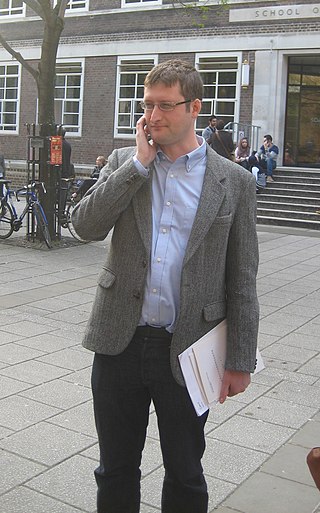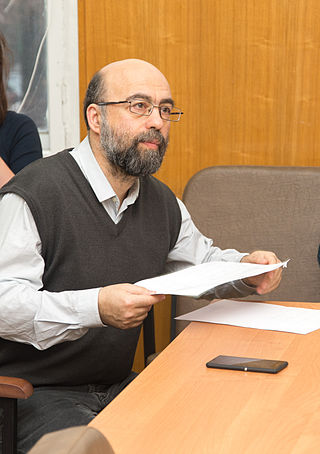Related Research Articles
Linguistic typology is a field of linguistics that studies and classifies languages according to their structural features to allow their comparison. Its aim is to describe and explain the structural diversity and the common properties of the world's languages. Its subdisciplines include, but are not limited to phonological typology, which deals with sound features; syntactic typology, which deals with word order and form; lexical typology, which deals with language vocabulary; and theoretical typology, which aims to explain the universal tendencies.
A sprachbund, also known as a linguistic area, area of linguistic convergence, or diffusion area, is a group of languages that share areal features resulting from geographical proximity and language contact. The languages may be genetically unrelated, or only distantly related, but the sprachbund characteristics might give a false appearance of relatedness.
In geolinguistics, areal features are elements shared by languages or dialects in a geographic area, particularly when such features are not descended from a proto-language, or, common ancestor language. That is, an areal feature is contrasted to lingual-genealogically determined similarity within the same language family. Features may diffuse from one dominant language to neighbouring languages.
Two types of language change can be characterized as linguistic drift: a unidirectional short-term and cyclic long-term drift.
Bernd Heine is a German linguist and specialist in African studies.

Leizhou or LuichewMin is a branch of Min Chinese spoken in Leizhou city, Xuwen County, Mazhang District, most parts of Suixi County and also spoken inside of the linguistically diverse Xiashan District. In the classification of Yuan Jiahua, it was included in the Southern Min group, though it has low intelligibility with other Southern Min varieties. In the classification of Li Rong, used by the Language Atlas of China, it was treated as a separate Min subgroup. Hou Jingyi combined it with Hainanese in a Qiong–Lei group.
Martin Haspelmath is a German linguist working in the field of linguistic typology. He is a researcher at the Max Planck Institute for Evolutionary Anthropology in Leipzig, where he worked from 1998 to 2015 and again since 2020. Between 2015 and 2020, he worked at the Max Planck Institute for the Science of Human History. He is also an honorary professor of linguistics at the University of Leipzig.

Waxiang is a divergent variety of Chinese, spoken by the Waxiang people, an unrecognized ethnic minority group in the northwestern part of Hunan province, China. Waxiang is a distinct language, very different from its surrounding Southwestern Mandarin, Xiang Chinese and the Hmongic Qo Xiong languages.
Laurent Sagart is a senior researcher at the Centre de recherches linguistiques sur l'Asie orientale unit of the Centre National de la Recherche Scientifique (CNRS).

Guillaume Jacques is a French linguist who specializes in the study of Sino-Tibetan languages: Old Chinese, Tangut, Tibetan, Gyalrongic and Kiranti languages. He also performs research on the Algonquian and Siouan language families, and publishes about languages of other families such as Breton. His case studies in historical phonology are set in the framework of panchronic phonology, aiming to formulate generalizations about sound change that are independent of any particular language or language group.
Scott DeLancey is an American linguist from the University of Oregon. His work focuses on typology and historical linguistics of Tibeto-Burman languages as well as North American indigenous languages such as the Penutian family, particularly the Klamath. His research is known for its diversity of its thematic and theoretical reach.
Language complexity is a topic in linguistics which can be divided into several sub-topics such as phonological, morphological, syntactic, and semantic complexity. The subject also carries importance for language evolution.
Cahiers de Linguistique Asie Orientale is a peer-reviewed academic journal of East Asian linguistics that was established in 1978 and is published by Brill. The articles published before 2007 are in free access on the Persée website.

Nathan Wayne Hill is an American historical linguist and Tibetologist specializing in languages of the Sino-Tibetan family, in particular Tibetic languages.

Andrej Kibrik is a Russian linguist, the director of the Institute of Linguistics of the Russian Academy of Sciences, and professor at the Philological Faculty of the Moscow State University. Member of the Academia Europaea since 2013.

Vladimir Plungian is a Russian linguist, specialist in linguistic typology and theory of grammar, morphology, corpus linguistics, African studies, poetics.
Mena B. Lafkioui is a linguist specializing in Berber languages. She is currently Research Director at the French National Centre for Scientific Research and Professor of Berber Linguistics at the School for Advanced Studies in the Social Sciences.
Yiya Chen is a linguist and phonetician specializing in speech prosody. She is professor of phonetics at Leiden University as well as senior researcher at the Leiden Institute for Brain and Cognition.
Isabelle Bril is a senior researcher at the French National Centre for Scientific Research and a member of LACITO specializing in morphosyntax, semantics, typology, and Austronesian languages.
References
- 1 2 3 4 5 "Hilary M. Chappell". Academia Europaea. Retrieved 29 January 2023.
- 1 2 3 4 "Hilary Chappell". 2009 Linguistic Institute. Retrieved 29 January 2023.
- 1 2 3 4 5 6 "Hilary M. Chappell - Biography". Academia Europaea. Retrieved 29 January 2023.
- ↑ "The hybrid syntactic typology of Sinitic languages". CORDIS. Retrieved 29 January 2023.